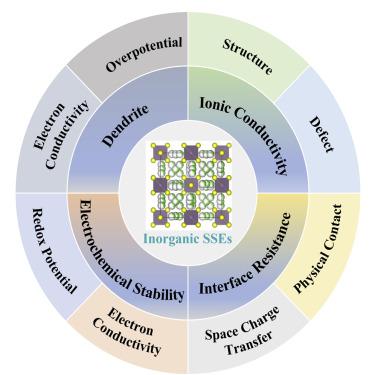Joule ( IF 39.8 ) Pub Date : 2022-03-16 , DOI: 10.1016/j.joule.2022.01.015 Xuyong Feng , Hong Fang , Nan Wu , Pengcheng Liu , Puru Jena , Jagjit Nanda , David Mitlin

|
The design of solid-state electrolyte (SSE) entails controlling not only its bulk structure but also the internal (e.g., grain boundary and pore) and heterophase (e.g., anode-SSE reaction layer) interfaces. Moreover, defects are integral for establishing both the initial all-solid-state battery (ASSB) cell performance and its ultimate cycling lifetime. This topical review discusses 5 highly promising inorganic lithium-, sodium-, and potassium-based SSEs, providing case studies of strategies to enhance ionic conductivity, tune the internal and heterophase interfaces, and prevent dendrites and deleterious side reactions. The primary focus is on garnet LLZO (Li7La3Zr2O12), argyrodite (Li6AS5X, A = P, Sb and X = Cl, Br, I), Na3AB4 (A = P, Sb, As and B = S, Se), and NASICON-type electrolytes, with several exploratory potassium systems being presented as well. The article begins with a discussion of the superionic conduction mechanisms, which is assisted by defects, topology, correlation, and disorder. The discussion then shifts to the thermodynamic or kinetic phase stability of metastable SSEs, followed by the SSE internal interfaces (pores and grain boundaries), and finally the complex microstructure associated with the reactive boundaries between the SSE and the metal anode and the SSE and the high-voltage ceramic cathode. This review explores why SSE systems with highly promising bulk ionic conductivity values do not demonstrate comparable performance in full cells. A major cause is the cycling-induced formation of ionically insulating but electrically conducting new phases at both the anode and the cathode. For the SSEs that do not rapidly decompose when contacting the anode, site-specific variations in ionic conductivity/electrical resistivity lead to growth of metal dendrites. In each electrolyte class, creative fabrication strategies have been employed to minimize, but not fully eliminate, new phase formation and dendrites, creating ample opportunities for additional analytical and synthesis-focused research. The emphasis of the discussion is on the bulk doping strategies for SSEs, emerging simulation and characterization findings in relation to SSE performance and cell failure, and new synthesis approaches and cell architectures to improve cycling stability. Throughout the article, outstanding scientific questions are identified, and future research directions are proposed.
中文翻译:

锂、钠和钾电池新兴无机固态电解质的改性策略综述
固态电解质 (SSE) 的设计不仅需要控制其整体结构,还需要控制内部(例如,晶界和孔)和异相(例如,阳极-SSE 反应层)界面。此外,缺陷对于建立初始全固态电池 (ASSB) 电池性能及其最终循环寿命都是不可或缺的。本专题综述讨论了 5 种极具前景的无机锂基、钠基和钾基 SSE,提供了提高离子电导率、调整内部和异相界面以及防止枝晶和有害副反应的策略的案例研究。主要重点是石榴石 LLZO (Li 7 La 3 Zr 2 O 12 )、银汞石 (Li 6 AS 5X、A = P、Sb 和 X = Cl、Br、I)、Na 3 AB 4(A = P、Sb、As 和 B = S、Se)和 NASICON 型电解质,以及几种探索性钾系统。本文首先讨论了由缺陷、拓扑、相关性和无序辅助的超离子传导机制。然后讨论转向亚稳态 SSE 的热力学或动力学相稳定性,然后是 SSE 内部界面(孔和晶界),最后是与 SSE 和金属阳极之间的反应边界以及 SSE 和高压陶瓷阴极。这篇综述探讨了为什么具有非常有希望的体离子电导率值的 SSE 系统在全电池中没有表现出可比的性能。一个主要原因是循环诱导在阳极和阴极处形成离子绝缘但导电的新相。对于在接触阳极时不会快速分解的 SSE,离子电导率/电阻率的位点特异性变化会导致金属枝晶的生长。在每个电解质类别中,都采用了创造性的制造策略来最小化但不完全消除新相的形成和枝晶,从而为额外的分析和合成研究创造了充足的机会。讨论的重点是 SSE 的体掺杂策略、与 SSE 性能和电池故障相关的新兴模拟和表征结果,以及提高循环稳定性的新合成方法和电池架构。在整篇文章中,


























 京公网安备 11010802027423号
京公网安备 11010802027423号